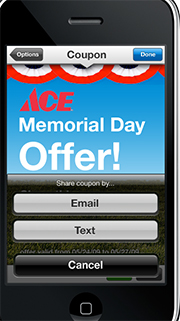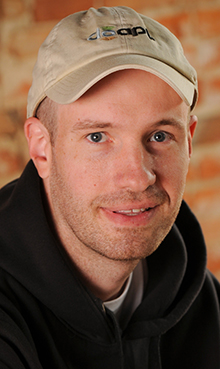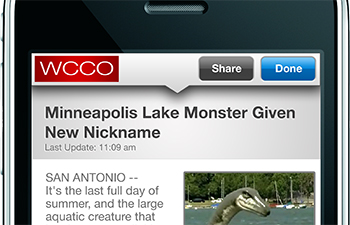The buzz surrounding mobile and tablet apps is deafening. Media companies of all sizes are considering how mobile apps might help a hurting bottom line, leading them to consider mobile ads or paid apps. The We Media folks even threw a one-day Tablet Throwdown so media companies could show off their iPad apps and talk about possible business models.
But what’s a local media outlet to do? Apps are costly to create, and you need to make them for iPhones, iPads, Android, Blackberry and more.
Into that void step the folks at DoApp, a self-funded startup in Minneapolis that has transformed itself from a utility and game app maker into a partner with local TV and newspaper outlets who want news apps. In fact, DoApp says it has 120-plus local media apps built and a total of 185 signed on.
What makes the startup so successful in getting local media outlets to use their services? DoApp CEO Wade Beavers told me it’s the low cost charged for apps that run on multiple platforms. He said DoApp typically charges media companies $750 to $1,000 per month, with a split of ad revenues, and says some outlets are already turning a profit based on that arrangement.

“We build them an Android, iPhone, and even a Blackberry WAP [site],” Beavers said. “It’s very affordable. We’ve heard a lot about media companies in financial trouble so we said, ‘Let’s make this a no-brainer.’ They pay hundreds of thousands of dollars for content management systems. We’re a mobile content management system and they’re paying a fifth or even a tenth of the price.”
While DoApp made a name for itself with utility apps like MyLighter (turning your iPhone into a lighter), the startup has made local media a focus with its Mobile Local News platform (“The Best Mobile App You Never Had to Build”), and a budding local mobile ad network, AdaGoGo. But DoApp faces serious competition from Apple’s own iAds network, as well as various app developers such as Verve Wireless, which has worked with Hearst, Cox, Belo and the AP.
I recently talked with DoApp CEO Wade Beavers, who previously worked at IBM in user experience, and founder Joe Sriver, who worked as the first user interface designer at Google, to hear more about how their service works, what they are offering publishers, and their view on geo-targeted local mobile advertising. The following is an edited transcript of our phone conversation.
Q&A
Tell me about how your company got into creating mobile apps for news organizations?
Joe Sriver: The company’s roots are back in ’07 [when] I started a company called PagePal. It was a website widget development company … We shifted our focus from widget development to mobile development. And that’s just when the iPhone SDK came out, and at first we were trying to get our feet wet so developed some games and utility apps.
We created MyLite and MyLighter, which creates a virtual lighter, and they were two of the top downloaded apps in the App Store for ’08. We did some work with Sony BMG for their artist David Cook who had won “American Idol,” so we did an app for them. At first we were seen as an iPhone gaming company, but we knew it was just to [build experience] on the platform, and we would do something bigger. We had contacts at WCCO, the local CBS affiliate here in Minneapolis, and they wanted to get their content delivered on mobile. So that got us into mobile local news, and we teamed up with another group to deliver journalism content from TV stations or newspapers on mobile devices. Our Mobile Local News product has had about a year of development on it, and we’ve been able to achieve most popular status for the number of apps we have for local TV stations and newspapers around the U.S. We have the most apps out there among our competitors.
So how many local outlets are using your services?
Wade Beavers: We have about 120-something in the store and about 185 signed, so another 50 or so coming out to market. I can tell you that on a daily basis I’m getting three to four calls from companies who want this service. About a year ago, when we talked about local mobile, a lot of them were intrigued by it, but now they’re scurrying; they’re feeling like mobile is definitely an important point for distribution. A year ago, we had to do a whole lot more convincing. Now we’re getting calls from smaller local properties. I have one down in Mississippi, where the town’s entire population is 10,000. I was surprised.
When we started the Mobile Local News product, we saw the handwriting on the wall. I’m 40 and Joe is in his mid-30s, and we have employees in their mid-20s, and I see the lack of them using print regularly, and the way they consume information is asynchronous — ‘when I want it.’ It’s hard to get people to sit down and watch the 6 o’clock or 10 o’clock news, and it’s hard to get people to take the paper. You capture everything in nuggets of information, and that’s when we said mobile makes sense because the phone is such an appendage to people, it’s not even funny. You take it away for a day and people go through withdrawal.
Sriver: There’s a lot of news aggregation sites like Google News, but for me, I still want to know local news, and the local TV and newspapers have a trusted brand that they’ve been developing for 50 years or more. There’s still a need for truly local news.
How does the business model work? If a news property wants you to develop an app for them, how do you charge them?

Beavers: We have two models we work with: One is a subscription model with an ad revenue share; or a straight revenue share with limited monthly costs to help them get going. But the reason for that is we built an ad network called Adagogo, with geo-targeted ads we can serve. When people see it working, their jaws just drop open, because we draw a circle on a map and say that when your app is open in that area, your ad will be served. When you have that kind of detailed functionality it’s pretty impressive, and we have digital coupons that can be shared on Facebook and Twitter with one click. So they get it.
Adagogo is something we want to grow; that’s our business model. What we got tired of was people built ad networks like AdMob, and then they let developers build apps, but there’s a true disconnect, because ad networks don’t understand how to make apps. And app developers don’t understand how to integrate an ad. We know how to do that. So when [Apple CEO] Steve Jobs says that mobile ads suck, we say that we’ve been doing this for a year creating a great experience.
So is it a plug-and-play platform so publishers can decide what to put into the app? Where to put sports, weather, etc.?
Beavers: Exactly. They can create it and move things around and decide what is a priority and not. We also let them change the navigation color. It’s scalable so they can add categories on the fly without having to re-submit to the App Store. We realized that news and information changes so much that we had to build this scalable. Before we built ours, we weren’t the first in market, but we did our homework and said, ‘How do these news outlets work?’ We found out that they’re not technical people, they’re writers, they have different jobs, so we knew this had to be easy. If it wasn’t, then you’re going to run into all kinds of problems. We even created a ‘feed cleaner’ where we could take a feed with a photo image that would be too large and compress it on the fly so it could go through the data network faster.

There were things we learned along the way to improve that experience. We definitely didn’t want to do — what many competitors have done — which is throw a WAP [Wireless Access Protocol mobile website] inside of an app. We didn’t want that. I commend Apple for putting the kibosh on that because you’re not even using the phone the way you’re supposed to. Why don’t you just make a WAP, why are you making an app? We have geo-targeted weather and traffic for cars. We built things that were useful for having on your phone.
Sriver: The main point for newspapers is that it would integrate into what they already have. So they have RSS feeds on their website, and they can simply add those RSS feeds into our back end and they don’t have to do any extra footwork. We use what they already have, and it’s easy to get up and running. We can usually get their app into the store in 30 days or less — and usually it’s less than 15 days.
Beavers: We also added user-generated content so people can take a photo or a video right within the app and submit it within the app. And no one was doing that besides CNN. We do it on a scale of 100-plus properties. And we do it on Android too. When we did that, we should have promoted it more. The stations love it. Most of what they get is weather and local sporting events. They’ll get their traditional inappropriate things [laughs].
Does it cost different amounts for each platform, or does one subscription fee pay for all of them?
Beavers: It’s one cost for all the platforms. We decided that as we add more functionality, we’re not going to itemize that. User-generated content or geo-targeted traffic — we added those in one of our updates and everyone can use it. They can just turn it on, and we don’t charge extra. We think of it as an ongoing thing and we’ll keep improving the product. We did nine updates in the app in the last 12 months, and they were all major updates, not just bug fixes.
Everyone talks about Pandora. That’s single-handedly created a competitor to local radio. News properties need to figure that out, too, because the New York Times announced it would go into local markets, and CNN is trying to do that as well as ESPN going into cities and having ESPN Dallas and ESPN Chicago. So local news outlets need to start thinking about ways of using new technology or they’re going to be challenged. Their one advantage is local and they better start providing that or others like CNN will.
Do the outlets set a price for the apps if they want to charge?
Sriver: In all the ones we’ve done, we say that we recommend you make them free, and ad revenues is where they’ll make their money. Paid walls are a big issue, and a lot of them want to charge. I think charging for the app is fine, but what I’ve seen is that when people put up paid walls your number drops immensely. Could you make that up by giving it away for free and getting ad revenues? Yeah, you would tend to make more that way. Unless you have really unique content.
Beavers talks about who DoApp considers to be competitors in developing apps for media companies:
When these local news outlets first went online, they used providers like WorldNow and IBS to help them develop their websites. A lot of the sites looked similar. Is that the same problem with these apps, that they look cookie-cutter in design?
Beavers: I would say that’s true, and with our design, the navigation is the same. But they can definitely brand it differently, they can change the color, but it does have the same feel when you open the app. But you know what’s funny? If you look at all the other news apps, they’re all the same because they’re using Apple’s SDK. They have five buttons on the bottom — four are categories and then you have a ‘More’ button. We wanted to do something different, and everyone says they love our navigation design.
Sriver: The other point is that the percentage is very low of people who download the app from the Daily Herald as well as WCCO and someplace out in California. For an individual user, they probably don’t know that a sister station in New York has the same interface and they wouldn’t care.
Beavers: If someone wants uniqueness, we can do that for them if they pay for it. But I always tell them there’s a cost for that. There’s more we can do for a fee. But you know what’s funny? The content is king. What they provide is the key. There are some apps that are good and some that are bad based on the fact that some don’t provide good content and others do a great job.
People have complained that some apps don’t allow comments on stories or don’t have outside links to the web. Is that something you leave to the publisher to decide to include?
Beavers: There’s about 40 or 50 different commenting technologies out on the web. Every time we talk to a group, they ask whether we can include those. But who’s going to monitor and manage the acceptable terms and what people put in there like expletives? Otherwise we have to tie into all those technologies. We can for a fee, and most of them say they don’t want it.
Sriver: The other thing is the form factor of a mobile device being so small and it’s difficult to type on. So that might thwart someone from commenting because it takes people so long to type. With the iPad, that might be a feature we want to integrate because the keyboard is much bigger. So we might circle back on user comments or interactive elements. Outside links work, and publishers can put those in there. We launched a light version of the browser within the app, and technically they could do commenting the same way if they wanted to. A link could bring up a browser session to do that, but no publisher has asked for that yet — but they could.
Beavers talks about how he thinks there isn’t a problem distinguishing between advertising and editorial on mobile apps:
What kind of ads do you offer? Interstitials, roadblocks, rich media?
Beavers: We do, and we’re adding more. One of the things we’re working on is a splash interstitial. We have billboards, we’ve got banners and we integrated ads into RSS feeds on the fly, which is patented technology that we have. Video pre-roll ads are the next one we’ll be rolling out. It’s one of those things that a lot of people think they want, but so far with the video numbers on mobile across news it’s not as high as viral video where people watch the kid in the back seat who came back from the dentist’s office.
Sriver: The other thing about ads is that they can get annoying for the user if a lot of these ads from AdMob are national ads. If I’m reading a local article about a sewer system, and there’s an ad to download [a game] that’s not relevant for me. But if I see a local ad about cleaning your sewer or it’s a time-based ad at lunchtime with a local restaurant ad that comes up with a two-for-one deal … I would feel better showing relevant ads, which would ease people’s hesitation to put ads in the app.
Do you have people buying ads through your network, or are outlets selling ads into their apps? How does that work?
Beavers: We end up doing both. We provide the path for outlets to sell locally, and we also have an opportunity as we are negotiating some national ads for people. But we also have a self-serve component, so any advertiser could choose what app they want to be in depending on geo-location.
Sriver: Right now, if you download our apps, you’ll probably say that the ads aren’t relevant. But it’s a gradual process where we’re building up the Adagogo network on our side. In the next six to nine months I think we’ll gain more traction for local ads. The Denver station and the station up in Seattle are selling local ads, but once we release the self-serve ad service, local mom and pop shops can come in and advertise their stores and the local aspect will…
Beavers: The other part is that because they can sell geo-targeted, you may get the [Minneapolis CBS TV affiliate] WCCO app. You’re in San Francisco and if you open the WCCO app, you’ll get national ads or geo-targeted ads for that area because WCCO will have local businesses, but businesses will be able to choose where ads can run geo-targeted. Research has shown that 50 percent of your transactions are done within a five-mile radius of where you live and where you work. So why wouldn’t an advertiser want to serve ads based on geo-location? It makes sense.
Sriver talks about the difficulty in finding out market penetration for apps in each locale:
*****
What do you think about DoApp’s local media apps? Do you use them, or have you contracted with them to develop apps for you? Share your experiences in the comments below.
Mark Glaser is executive editor of MediaShift and Idea Lab. He also writes the bi-weekly OPA Intelligence Report email newsletter for the Online Publishers Association. He lives in San Francisco with his son Julian. You can follow him on Twitter @mediatwit.


Great post Mark! Thanks and keep up the good work! your posts are always fun to read!
Btw, I often use DoApp’s local media apps and I think they’re not so bad!
I didn’t use this. But i think it is working.
thanks for it, nice to read. but mobile web is not my way to use the net.